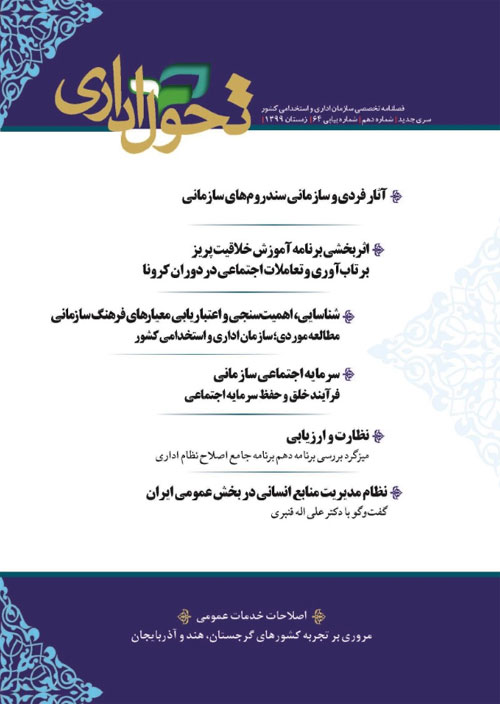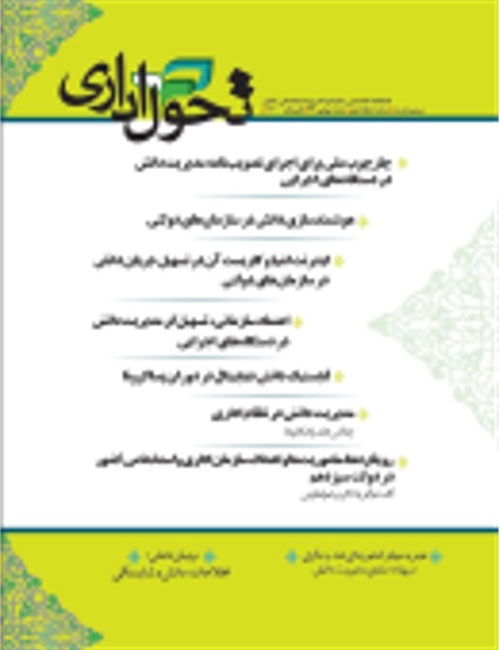فهرست مطالب

نشریه تحول اداری
پیاپی 64 (زمستان 1399)
- تاریخ انتشار: 1400/05/12
- تعداد عناوین: 11
- بخش اول: مقالات
-
صفحه 6
امروزه سندروم های سازمانی یکی از پدیده های نوین در مدیریت منابع انسانی به شمار می روند. سندروم ها از جمله آسیب های مهم سازمان به شمار می آیند که در صورت نادیده انگاشتن موجب بروز مشکلات جدی در سازمان خواهند شد. این مقاله با هدف تبیین و تشریح مفاهیم برخی از مهم ترین و اثرگذارترین سندروم های سازمانی تدوین و سعی شده است تا به بررسی عوامل و آثار فردی و سازمانی و نیز راه کارهای پیش روی مدیران به منظور حفظ، ارتقا و تقویت منابع سازمانی بپردازد. روش تحقیق مروری بوده و از طریق روش کتابخانه ای و مرور مقالات صورت گرفته است. با توجه به اهمیت و ضرورت مسئله سندروم های سازمانی و آسیب های ناشی از آن، با تکیه بر قوانین و مقررات جاری و تقویت زیرسیستم های منابع انسانی و با درنظرگرفتن مهم ترین مولفه های هر سازمان نظیر کارایی، اثربخشی منابع انسانی و بهره وری سازمان، پیشنهاد ها و راه کارهای متناسب ارایه شده است.
کلیدواژگان: سندروم های سازمانی، مدیریت منابع انسانی، زیرسیستم های منابع انسانی، بهره وری -
صفحه 16
برنامه های آموزشی و تربیتی برای توسعه مهارت های منابع انسانی، با هدف بهبود عملکرد سازمانی و تقلیل هزینه ها و همچنین افزایش بهره وری، به منظور بقا و تعادل زیستی و روانی ضروری است. ارتقاء توانمندی های مقابله کارآمد با بحران ها و افزایش سلامت روانی کارکنان با برنامه های آموزشی محقق می شود. در شرایط اضطرار، برنامه های آموزشی مجازی برای امنیت بخشی و تعادل پس از بحران، ابزاری مهم برای مربیان است. پژوهش حاضر با هدف بررسی اثربخشی برنامه آموزش خلاقیت پریز بر تاب آوری و تعاملات اجتماعی با رویکرد آینده نگری در بحران کرونا انجام شده است. روش انجام پژوهش، شبه آزمایشی به صورت پیش آزمون و پس آزمون با گروه کنترل است. ابزار گردآوری اطلاعات، پرسشنامه تعاملات اجتماعی صادق پور و رمضان نژاد و تاب آوری خانواده سیکسبی است. برای تجزیه وتحلیل داده ها از آزمون تحلیل کوواریانس چند متغیره و نرم افزار SPSS استفاده شده است. نتایج پژوهش نشان می دهد میانگین تعاملات اجتماعی و تاب آوری در گروه آزمایش پس از آموزش به طور معنا داری افزایش یافته است و در نمرات پس آزمون نسبت به گروه کنترل تفاوت معناداری وجود دارد؛ بنابراین می توان نتیجه گرفت برنامه آموزش خلاقیت پریز به طورکلی می تواند منجر به تغییر و بهبود تعاملات اجتماعی و تاب آوری در شرایط بحران شود.
کلیدواژگان: برنامه آموزش خلاقیت پریز، تاب¬، آوری، تعاملات اجتماعی، آینده نگری، نظام اداری -
شناسایی، اهمیت سنجی و اعتباریابی معیارهای فرهنگ سازمانی / مطالعه موردی؛ سازمان اداری و استخدامی کشورصفحه 30
در نظام اداری ایران، طی سالیان طولانی و به شکل کاربردی، کمتر به مقوله فرهنگ سازمانی توجه شده است؛ لکن در سال های اخیر ضرورت ورود به این موضوع کاملا درک شده و در این راستا اقداماتی در دستور کار قرار گرفته است. از جمله این اقدامات، تدوین نظام نامه مدیریت توسعه فرهنگ سازمانی است که بر اساس آن، دستگاه های اجرایی موظف به پیاده سازی معیارهای عمومی رفتاری و شغلی و همچنین تدوین و اجرای معیارهای اختصاصی فرهنگی خود هستند. سازمان اداری و استخدامی کشور به عنوان متولی اصلی موضوع، مطالعه و تدوین معیارهای فرهنگ سازمانی را در دستور کار قرار داده و پژوهش حاضر برگرفته از مطالعات انجام شده در این ارتباط است. یافته های این پژوهش در دو بخش، اهمیت سنجی و اولویت بندی معیارهای عمومی؛ و شناسایی و تدوین معیارهای اختصاصی فرهنگ سازمانی دسته بندی شده است. در این پژوهش از دو رویکرد کمی و کیفی استفاده شده است. برای گردآوری داده ها از ابزار پرسشنامه و برای تحلیل، از روش توصیفی-پیمایشی و آزمون t تک نمونه ای و آزمون فریدمن بهره گرفته شده است. به منظور تدوین معیارهای اختصاصی نیز، در ابتدا اسناد و مدارک فرادستی قانونی بررسی شده و سپس با استفاده از تکنیک دلفی و دریافت نظر خبرگان در چندین مرحله، معیارهای نهایی شناسایی شده اند. یافته ها نشان می دهد سه معیار برخورداری از وجدان کاری، روحیه امانت داری و روحیه خدمت گزاری به مردم در میان معیارهای عمومی رفتاری؛ و سه معیار انجام وظایف به نحو مطلوب، پاسخگویی و تکریم ارباب رجوع در میان معیارهای عمومی شغلی از بالاترین اولویت برخوردارند. در موضوع تدوین معیارهای اختصاصی نیز، دوازده معیار شناسایی و به تصویب شورای راهبری توسعه مدیریت سازمان رسیده است که برخی از آنها عبارت اند از: پیشگامی، قانون مداری، عدالت محوری، دانش محوری، شفافیت و برنامه محوری.
کلیدواژگان: فرهنگ سازمانی، معیارهای عمومی، معیارهای اختصاصی، معیارهای رفتاری و شغلی -
صفحه 45
سرمایه اجتماعی سازمانی کمیت و کیفیت روابط درون سازمانی را نشان می دهد و می تواند تسهیلگر مهمی در ایجاد اصلاحات اداری در سازمان های دولتی باشد. با وجود اهمیت این سرمایه در بهبود ارایه خدمات در سازمان های دولتی، مطالعات تجربی نشان داده است وضعیت سرمایه اجتماعی در سازمان های کشور مناسب نیست. در این مقاله مروری، پس از تبیین مفهوم سرمایه اجتماعی سازمانی، چگونگی خلق و حفظ سرمایه اجتماعی سازمانی مورد بررسی قرار گرفته است. عوامل تاثیر گذار بر فرایند شکل گیری سرمایه اجتماعی سازمانی را می توان در 4 دسته فردی، مدیریتی، ساختاری و فرهنگی قرار داد. عامل مدیریتی بیشترین نقش را در شکل گیری سرمایه اجتماعی سازمانی بازی می کند. خلق و حفظ سرمایه اجتماعی نیازمند وجود شرایطی است که عبارت اند از: زمان، وابستگی متقابل، حل اختلافات، و تعامل.
کلیدواژگان: سرمایه اجتماعی سازمانی، خلق و حفظ سرمایه اجتماعی سازمانی، سازمان دولتی - بخش دوم: دیدگاه
-
نظارت و ارزیابی / میزگرد بررسی برنامه دهم از برنامه جامع اصلاح نظام اداریصفحه 58
-
نظام مدیریت منابع انسانی در بخش عمومی ایران / گفت و گو با علی اله قنبریصفحه 67
- بخش سوم: تجربیات موفق
-
صفحه 74
- بخش چهارم: دانشنامه
-
صفحه 84
-
صفحه 87
-
صفحه 89
-
صفحه 92
-
Page 6
Today, organizational syndromes are one of the new phenomena in human resource management and on the other hand is a new category in Iranian and world societies. This article has been compiled with the aim of explaining the concepts of some of the most important and effective organizational syndromes and has tried to examine the causes and factors, individual and organizational effects as well as the solutions facing managers. The method of this research is review and it has been done through library method and review of articles. Due to the importance and necessity of organizational syndromes and the resulting damage to the most important components of any organization such as efficiency and effectiveness of human resources, organizational productivity, etc., suggestions based on current laws and regulations and strengthening human resource subsystems Has been.
-
The effectiveness of PRIZ creativity training program on resilience and social interaction in CoronaPage 16
Training programs are among the required skills required for human resources. They aim to improve organizational performance, reduce costs, and increase organizations' productivity. As during the current situation, they are essential for survival, biological and psychological balance. Improving the capabilities of coping effectively with crises and increasing the individuals' mental health in efficient organizations can be achieved through training programs. As a useful tool for educators, virtual training programs can provide security and prevent post-crisis imbalances in emergencies. This study aims to investigate the effectiveness of PRIZ creativity training program on resilience and social interactions with the Foresight approach in the Coronavirus crisis by the quasi-experimental method with pre-test, post-test, and control group. Data collection tools were Sadeghpour and Ramezannejad social interaction questionnaire and Sixbey's family resilience assessment. Multivariate analysis of covariance and SPSS24 software were used to analyze the data. The results showed that the mean of social interactions and resilience in the experimental group increased significantly after training. There was a significant difference in the post-test scores of the experimental group compared to the control group. Therefore, it can be said that the PRIZ creativity training program, in general, can lead to change and improvement of social interactions and resilience in crisis.
-
Page 30
The subject of organizational culture has been less applied in the administrative system of Iran for many years, but in recent years, the Necessity to enter this subject has been fully understood and measures have been put on the agenda. Including these measures is codification of organizational culture development management instruction, based on that, each of agencies is obliged to implementing the general behavioral and professional criteria, and also required to identify and formulate its own specific cultural criteria and implement them. The administrative and recruitment organization, as the main administrator of the issue, formulates organizational cultural criteria and the current article is taken from a study conducted in this regard. The findings are presented in two parts: Assessing the importance and prioritization of the general criteria as well as identifying and formulating specific criteria for organizational culture. In this research, two quantitative and qualitative approaches have been used. Quantitative approach and descriptive-survey method have been used in prioritizing general criteria. A questionnaire was used to collect data and a descriptive-survey method, one-sample t-test and Friedman test were used for analysis. Also, in order to formulate specific criteria, first the legal and scientific superior documents were reviewed and then the final criteria were identified using the Delphi technique and receiving the opinion of experts in several stages. Findings show that three criteria including work conscience, trusteeship and the spirit of serving the people among the general behavioral criteria and three criteria including performing duties well, responsiveness and honoring citizens among the general professional criteria have the highest priority. Also, in the matter of developing specific criteria for organizational culture, 12 criteria were identified and approved by the Council of Organizational Management Development, some of them are pioneering, rule of law, justice-oriented, knowledge-based, transparency and program-oriented.
-
Page 45
Social capital represents the quality and quantity of in-organization relationships which can facilitate administrative reforms in public organizations. Despite the significance of social capital in improving services offered by public organizations, empirical studies are indicative of low social capital in Iranian organizations. Reviewing organizational social capital, thus, this paper attempts to address the question “how can social capital be generated and sustained?” according to the literature review, factors contributing to the creation of social capital can be categorized into four groups: individual, managerial, structural, and cultural. Among all, managerial factors play the most significant role in creating social capital. In addition to abovementioned factors, for social capital to be created and maintained some conditions must be in place: time, mutual dependence, disclosure, and interaction.


